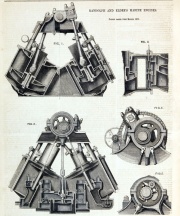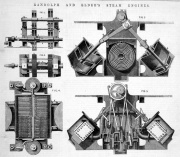Randolph, Elder and Co
Randolph, Elder and Co of Govan.
In 1834 Charles Randolph started his own firm of millwright engineers in Centre Street, Glasgow[1].
1852 John Elder joined as a partner and started making marine engines, a sideline that was to supersede the original work.
1853 In January 1853 they took out a patent for 'an arrangement of compound engines adapted for the driving of the screw propeller. The engines are vertical, direct-acting and geared. The pistons of the high and low pressure cylinders move in contrary directions and move diametrically opposed cranks with a view to diminution of strain and friction'
1854 First application of a compound engine to steam ship propulsion[2].
1860 Began making steamships in the yard of J. R. Napier[3].
1864 John Elder laid out the Fairfield Yard at Govan[4].
1865 See 1865 Clyde Shipbuilders for detail of the tonnage produced by Randolph, Elder and Co.
1868 Charles Randolph retired.
1869 John Elder died. After his death the company was run by his widow Isabella (1828 - 1905) and renamed John Elder and Co in his memory [5].
1870 William Pearce (later Sir William) took charge of the yard[6].
1870s The yard mainly made liners for a number of Far Eastern and Australasian companies, many of which went on to have long term associations with the yard, as well as 55 warships between 1870 and 1909[7].
1875 A letter setting out the achievements of John Elder was published in The Times demonstrating that the company name of John Elder and Co was certainly in use at this date[8].
1876 Won contract for three engine and boilers for Admiralty corvettes.
1878 Launched the first of 6 corvettes from the Fairfield Yard, Govan[9].
1880s Early users of manganese bronze propellors.
1882 W. Pearce of John Elder and Co became a founding director of Manganese Bronze and Brass Co[10].
1885 John Elders became the Fairfield Shipbuilding and Engineering Co; suffering from the depression in trade, launched only one quarter of the average of Clyde yards by tonnage (c.9000 tons)[11].
See Also
Sources of Information
- A Short History of Naval and Marine Engineering by E. C. Smith. Published 1937
- The Engineer of 3rd November 1876 p319



